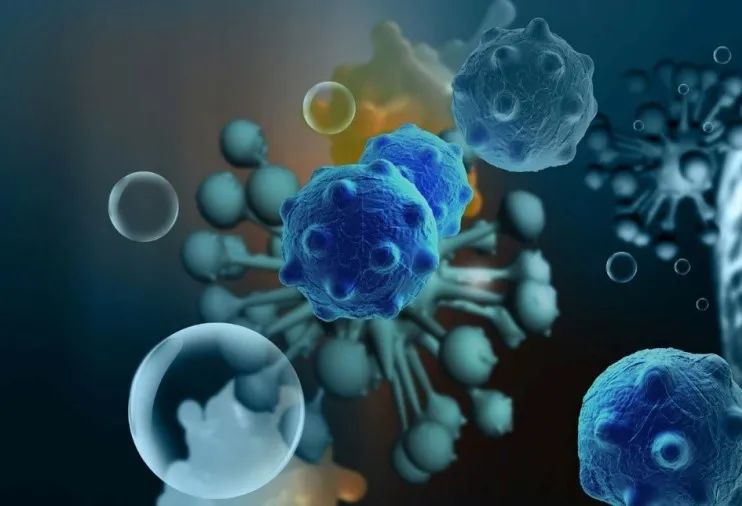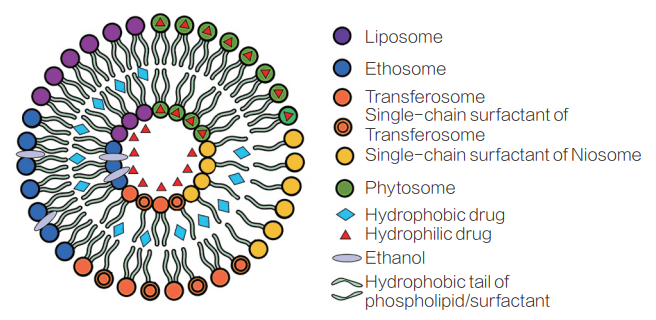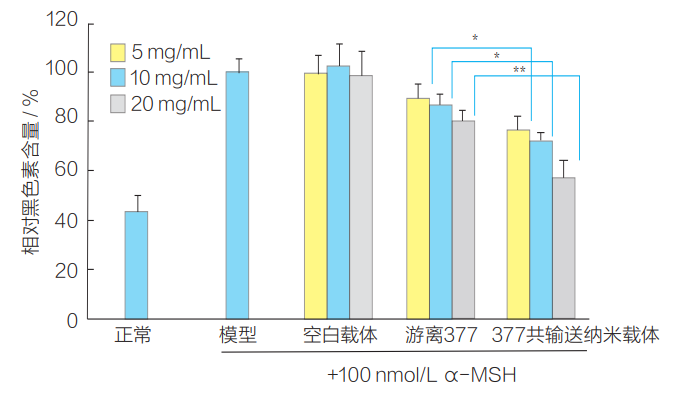Nano carrier technology - from transdermal drug delivery to functional cosmetics

Zhao Xiaojing1Hong Yanhan1Liu Wei1, 2
(1. National Nanodrug Engineering Technology Research Center, Huazhong University of Science and Technology; 2 College of Life Sciences and Technology, Huazhong University of Science and Technology
Transdermal drug delivery system, also known as transdermal drug delivery formulation, refers to a type of drug delivery system or formulation that delivers drugs through the skin to the site of action for disease treatment or prevention. The broad definition of transdermal drug delivery systems includes dermal drug delivery systems and transdermal drug delivery systems. The former acts on the skin or subcutaneous tissue, while the latter involves drugs being absorbed through the skin into the circulatory system to exert systemic therapeutic effects. Transdermal administration can avoid the first pass effect of oral administration on the liver, the damage to the gastrointestinal tract caused by drugs, and the stimulation of the gastrointestinal tract by drugs. It can also avoid the trauma and pain caused by injection administration, and improve medication compliance. Meanwhile, transdermal administration provides a new systemic delivery method for drugs that are not suitable for oral or injectable administration. There are two pathways for drugs to enter the systemic circulation through skin absorption, namely the epidermal pathway (including cross cellular and intercellular pathways) and the skin accessory pathway (hair follicles, sebaceous glands, sweat glands). Due to the low permeability of stratum corneum cells and the need for multiple hydrophilic/lipophilic environment distribution processes for drugs to pass through the transcellular pathway, the transcellular pathway only accounts for a very small portion of the epidermal pathway. Drugs mainly enter the active epidermis and dermis through intercellular pathways, and are then absorbed into the systemic circulation. The area occupied by skin appendages on the skin surface is only about 0.1%. Some ionic drugs and water-soluble macromolecular drugs have a slow penetration rate through the epidermal pathway due to their difficulty in passing through the lipid rich stratum corneum. Therefore, the skin appendage pathway is an important absorption pathway for these drugs.
The factors that affect the transdermal penetration of drugs include the drug's molecular weight, lipid water partition coefficient (logPo/w), melting point/thermodynamic activity, number of hydrogen bonding groups (hydroxyl, amino, halogen, etc. in the molecule), dissociation (pKa value), charge, skin adhesion, skin irritation/allergy, etc. The oil-water partition coefficient of drugs is one of the important factors affecting transdermal absorption of drugs. The stratum corneum is a lipid membrane, and drugs with strong lipid solubility are more likely to pass through the stratum corneum. After passing through the stratum corneum, drugs need to be distributed into the active epidermis. However, the active epidermis is a water-based tissue, and drugs with too strong lipid solubility are difficult to distribute into the active epidermis. The ideal drugs for transdermal absorption should have the following physicochemical properties and pharmacological characteristics: ① molecular weight less than 500Da; ② Melting point less than 200 ℃; ③ Moderate hydrophilicity and oleophilicity, with logarithmic values of lipid water partition coefficient ranging from 1 to 3; ④ No skin irritation, no occurrence of skin allergic reactions; ⑤ Low oral bioavailability and short biological half-life; ⑥ Has strong pharmacological activity, with a daily injection dose of less than 20mg.
At present, there are various strategies to promote transdermal drug penetration, such as changing the physical and chemical properties of drugs (prodrug, increasing drug thermodynamic activity), altering the stratum corneum (ultrasound introduction, chemical permeation, electroporation), penetrating the stratum corneum (microneedles, removal of stratum corneum), and electric driving (ultrasound introduction, ion electroporation, electroporation). Some scholars also divide the strategies for promoting transdermal drug penetration into two categories: active methods and passive methods. Active methods include thermal ablation (laser, radiofrequency), electrical methods (iontophoresis, electroporation), mechanical methods (microneedles), and other methods (needle free syringes, ultrasound); Passive methods include the use of new formulation technologies, chemical enhancers, co crystals, prodrugs, etc.
01 Nanocarrier technology
Nanodrugs are a new type of drug formulation developed using nanocarrier/nanocarrier technology, with the core technology being nanodrug delivery systems, also known as nanocarriers. Loading drugs onto nanocarriers with particle sizes ranging from 10 to 1000 nm for in vivo delivery can effectively increase the ability of drugs to penetrate biofilms, alter drug distribution in vivo, regulate drug release rate, and significantly improve drug bioavailability. Compared with traditional drug formulations, nanomedicine presents many new pharmacological and metabolic characteristics, such as long blood circulation, targeting, sustained and controlled release, high biological adhesion, special intracellular mechanisms, and the ability to co deliver multiple drugs. As one of the fields closest to industrialization and with the most promising development prospects in nanotechnology, the research and development of nanomedicine has become a frontier and hotspot in the current international pharmaceutical industry.
The specific forms of drug nanocarriers include microemulsion/nanoemulsion, nanovesicles, lipid nanoparticles (solid lipid nanoparticles, nanostructured lipid carriers), lipid liquid crystals, nanocrystals, polymer nanocarriers (polymer nanoparticles/nanocapsules, polymer micelles, nano gel, dendrimers, etc.), and inorganic nanocarriers (magnetic nanoparticles, mesoporous silicon nanoparticles, carbon nanomaterials, etc.). Drugs are loaded onto nanocarriers through various methods such as dissolution, dispersion, encapsulation, adsorption, and coupling. The size of nanocarriers is their primary characteristic and an important basis for exhibiting biological nano effects. In the field of materials science, the size of nanomaterials is defined as 0.1~100nm. Within this range, nanoparticles exhibit different physical and chemical properties from macroscopic bulk materials due to quantum size effects, volume effects, surface effects, quantum tunneling effects, and dielectric confinement. However, there are currently different views on the size range of drug nanocarriers. Numerous studies have shown that when the particle size of nanocarriers is between 10-1000nm, drugs exhibit significant differences in physicochemical properties, pharmacokinetics, and pharmacodynamics compared to conventional formulations, which constitute the material basis for the special biological effects of nanocarriers.
After drug loading onto nanocarriers, its physical and chemical properties such as saturation solubility, dissolution rate, crystal form, hydrophilicity and hydrophobicity, physical responsiveness such as light, electricity, magnetic field responsiveness, pH sensitivity, temperature sensitivity, as well as biological characteristics such as specific molecular affinity, cell affinity, biodegradability, etc., all change, affecting the absorption, distribution, metabolism, and excretion of drugs, namely the biopharmaceutical and pharmacokinetic behavior of drugs, such as transdermal/mucosal/blood-brain barrier characteristics, biological adhesion, in vivo stability, blood circulation characteristics, targeting, sustained release/controlled release characteristics, and cellular behavior, thereby achieving improved bioavailability, enhanced drug efficacy, reduced adverse drug reactions, improved drug administration, etc. Compliance and other purposes.
02 Application of nanocarrier technology in transdermal drug delivery
Nanocarrier technology promotes transdermal drug penetration without altering the structure of the skin's stratum corneum, avoiding damage to the skin barrier function. It is an ideal technology for promoting transdermal drug delivery. The use of nanocarriers can effectively promote transdermal absorption of drugs, significantly increase drug enrichment at the site of skin lesions, and achieve targeted delivery of drugs to the skin. Nanocarriers have good sustained-release and controlled release properties, which can act as reservoirs in skin tissues, continuously release drugs, and better exert their therapeutic effects; Meanwhile, the sustained release effect can effectively avoid the toxic side effects of toxic drugs on the skin at high doses. Nanocarriers can effectively improve the solubility and water dispersibility of poorly soluble drugs, avoiding the crystallization and precipitation of highly crystalline drugs during storage. The protective effect of nanocarriers can also effectively improve the stability of photosensitive and thermosensitive drugs.
Taking nanocapsules as an example, they consist of a bilayer structure composed of phospholipids, lipids, and lipids. Depending on their structure and composition, they can be divided into phospholipid liposomes, flexible liposomes (transporters), liposomes, non-ionic surfactant vesicles, etc. (Figure 1). Nanovesicles can encapsulate lipophilic drugs in the lipid bilayer and hydrophilic drugs in the internal aqueous phase, promoting transdermal drug penetration through mechanisms such as fusion (fusion of phospholipids and stratum corneum lipids), hydration (enhancing stratum corneum hydration, changing the arrangement and structure of hydrophobic parts in the stratum corneum lipid bilayer), and penetration (delivery bodies, liposomes, etc., rely on their deformability to penetrate the stratum corneum through water and air channels between keratinocytes).

Figure 1 Schematic diagram of different nanocapsules used for transdermal drug delivery
In the 1980s, econazole liposome gel, the first dermatological drug using nano carrier technology, was registered and listed in Switzerland. In recent years, with the development of nanocarrier preparation technology and quality control technology, as well as the gradual deepening of research on the transdermal penetration mechanism of nanocarriers, the application of nanocarriers in transdermal drug delivery has become increasingly widespread.
03 Application of Nanocarrier Technology in Functional Cosmetics
In 1986, Christian Dior launched the world's first liposome based cosmetic product (Capture), marking the beginning of research and application of nanocarrier technology in functional cosmetics. In recent years, functional cosmetic products using nanocarrier technology have been launched one after another, demonstrating the broad application prospects of nanocarrier technology in the field of cosmetics. Table 1 lists some commercially available functional cosmetics using nanocarrier technology.

Table 1 Some commercially available functional cosmetics using nanocarrier technology
Research has shown that nanocarriers can effectively promote the transdermal absorption of cosmetic functional ingredients, significantly increase the storage of cosmetic functional ingredients in the skincare target area, and enable the functional ingredients to enter the skincare target area and target cells; Nanocarriers have excellent sustained-release and controlled release properties, and can act as reservoirs in skin tissues, continuously releasing effective ingredients and achieving long-lasting skincare effects; Nano carriers can effectively improve the solubility and water dispersibility of poorly soluble cosmetic ingredients; Effectively improve the stability of photosensitive and thermosensitive functional ingredients; Improve the compatibility of functional ingredients.
Functional skincare products require multiple functional ingredients to exert synergistic effects. Specially designed nanocarriers can simultaneously load multiple functional ingredients with different physicochemical properties and mechanisms of action. Through transdermal co delivery of nanocarriers, the synergistic enhancement of multi effect and multi-target skincare functional ingredients can be achieved. For example, transdermal co delivery of functional ingredients with different moisturizing mechanisms such as repairing skin barriers, natural moisturizing factors, water replacement stress factors, and water locking moisturizing can significantly improve the moisturizing effect of cosmetics through the synergistic effect of multi effect and multi-target moisturizing functional ingredients. For example, according to the mechanism of skin whitening and brightening, effective ingredients with different mechanisms of action such as inhibiting tyrosinase activity, inhibiting melanin migration, antioxidant, anti-inflammatory repair, etc. are co delivered through the skin, promoting the enrichment of effective ingredients in the whitening and skincare target areas (active epidermis) and target cells (melanocytes), significantly enhancing the whitening and brightening effect of cosmetics. The use of nanocarriers to co deliver signal active peptides, neurotransmitter inhibitory active peptides, and antioxidant active peptides, which have multiple effects such as promoting collagen synthesis, inhibiting MMP enzymes, eliminating fine lines, and antioxidation, can significantly improve the stability and transdermal absorption of active peptides, achieving synergistic enhancement of anti-aging and wrinkle removing active peptides. The use of flexible liposomes to load functional ingredients with different mechanisms of action, such as inhibiting 5 α - reductase, promoting hair growth, and fixing hair, can achieve synergistic effects of multi effect and multi-target anti hair loss and fertility functional ingredients, while improving the stability of functional ingredients and reducing irritation.
The following is a research and development case study on the application of transdermal co delivery nanocarrier technology in functional cosmetics. Case 1: Phenylethylresorcinol co delivery nanocarrier. Phenethylresorcinol is a highly effective whitening ingredient that inhibits melanin production by suppressing tyrosine kinase activity. However, phenethyl resorcinol has poor water solubility, is unstable under light and heat, difficult to penetrate the skin barrier, and has a certain degree of skin irritation, which limits its application in cosmetics. The author has scientifically combined effective ingredients such as phenethyl resorcinol, nicotinamide, vitamin C ethyl ether, vitamin E, and glycyrrhetinic acid, which have mechanisms of inhibiting melanin production, migration, antioxidant, anti-inflammatory, and repair, to develop a phenethyl resorcinol co delivery nanocarrier. The research results showed that compared with the free active ingredients, co delivery of nanocarriers significantly increased the skin storage capacity of phenethyl resorcinol, which was more easily taken up by melanocytes, significantly inhibited tyrosinase activity and melanin production (Figure 2), and effectively inhibited melanosome transport. At the same time, nanocarriers significantly reduce the cytotoxicity of phenethyl resorcinol at high doses and significantly improve the photostability and thermal stability of the active ingredients. The results of the human efficacy evaluation showed that after 28 days of using co delivered nanocarriers, the subjects' skin whitening degree, melanin content, pigmentation, texture and other indicators were significantly improved.

Figure 2 Comparison of melanin production in B16F10 melanocytes among different treatment groups (* P<0.05, * * P<0.01)
Case 2: Beauty peptide co delivery nanocarrier. In recent years, active peptides have been widely used in anti-aging cosmetics, and the active peptides used in skincare products are called beauty active peptides, abbreviated as "beauty peptides". However, beauty peptides have problems such as easy degradation and inactivation, difficulty in transdermal absorption, and a single efficacy that requires the synergistic action of multiple beauty peptides. The author used nanoliposome vesicle technology to develop nanocarriers for co delivery of facial beauty peptides (loaded with palmitoyl tripeptide-5, acetyl tetrapeptide-5, palmitoyl pentapeptide-4, and myopeptide) and ocular beauty peptides (loaded with palmitoyl tripeptide-5, acetyl hexapeptide-8, acetyl tetrapeptide-5, and myopeptide). The in vivo skin penetration experiment of rats showed that nanocarriers can significantly promote the transdermal penetration of beauty peptides into deep skin tissues. The results of cell experiments showed that compared to free beauty peptides, co delivered nanocarriers are more easily taken up by human fibroblasts (HSF cells), which can protect HSF cells from H2O2 induced oxidative stress damage and reduce the level of intracellular reactive oxygen species (ROS). Meanwhile, nanocarriers can significantly promote the secretion of hyaluronic acid, type I and type IV collagen by HSF cells (P<0.05). The results of human efficacy evaluation show that the co delivery of beauty peptides onto nanocarriers significantly improves indicators such as skin elasticity, wrinkle volume, wrinkle area, and wrinkle area ratio compared to free beauty peptides.
Case 3: Co delivery of nanocarriers for preventing hair loss and reproduction. At present, hair loss is showing a trend towards youthfulness, and the demand for anti hair loss and hair growth products is increasing day by day. However, commercially available anti hair loss and growth products generally have problems such as single efficacy ingredients, poor stability, and strong irritation. Free efficacy ingredients are difficult to penetrate into hair follicles and accumulate in target sites and target cells (dermal papilla cells), which affects the effectiveness of anti hair loss and growth. Flexible liposomes have strong deformation and high penetration efficiency, and can penetrate and remain in hair follicles, achieving sustained and long-lasting release of active ingredients. The author developed a nanocarrier for co delivery of diaminopyrimidine oxide (Kopexil) and pyrrolidinyl diaminopyrimidine oxide (Kopyrol) using alcoholics technology to prevent de fertilization and co delivery. The results of cell experiments showed that co delivered nanocarriers are easily taken up by dermal papilla cells, significantly promoting their proliferation and significantly reducing intracellular ROS levels to resist oxidative damage; Significantly reduce the damage of androgens to dermal papilla cells; Significantly promote the secretion of type III collagen by hair follicle cells, which has a hair fixing effect. A model of androgenic alopecia was established in C57BL/6 mice treated with testosterone propionate, and hair growth was observed after 28 consecutive days of administration. The experimental results indicate that co delivery of nanocarriers can significantly promote the transition of hair follicles from the resting phase to the growth phase, effectively promoting hair regeneration in androgenetic alopecia model mice. The observation results of H&E staining of mouse skin hair follicles showed that the number of hair follicle regeneration in the nanocarrier group was significantly higher than that in the free active substance group (Figure 3). The results of over 100 human efficacy evaluations further validate the excellent anti shedding and reproductive effects of co delivered nanocarriers.

Figure 3 Comparison of physiological sections of mouse skin hair follicles stained with H&E in different treatment groups
04 Conclusion
The Regulations on the Supervision and Administration of Cosmetics have been officially implemented on January 1, 2021. In order to meet the increasingly developing social needs, promote innovation and development of transdermal drug delivery and efficacy cosmetics industry, the state encourages and supports innovation and application of advanced technologies, and improves the quality and safety level of efficacy cosmetics. Nanocarrier technology, as an innovative pharmaceutical formulation technology, effectively enhances the efficacy of cosmetic products, providing sufficient scientific basis for the efficacy claims of cosmetics. I believe that under the guidance of new regulations, nanocarrier technology will be more widely applied in functional cosmetic products.
Author Introduction

Liu WeiProfessor/doctoral supervisor at Huazhong University of Science and Technology, head of the Department of Nanomedicine and Biopharmaceuticals, and leader of the Nanoformulation discipline at the National Nanodrug Engineering Technology Research Center. Vice President of the Transcutaneous Administration Professional Committee of the World Federation of Chinese Medicine Societies, member of the Nanooncology Professional Committee of the China Anti Cancer Association, member of the China Personal Care Products and Cosmetics Science and Technology Innovation Expert Committee (CSTIC), and expert in the evaluation of the National Key Research and Development Program Nanotechnology Special Project. As the project leader, I have undertaken more than 10 projects including the National 863 Program, sub projects of the National 973 Program, and general projects of the National Natural Science Foundation of China. I have also undertaken over 30 enterprise cooperation projects and have won one second prize for scientific and technological progress from the Ministry of Chemical Industry, one first prize for scientific and technological progress from Hubei Province, and one third prize for scientific and technological progress from Hubei Province. Editor in chief of the first monograph in the relevant field in China, "Transdermal Drug Delivery Nanotechnology"; Published over 150 academic papers, including more than 80 SCI papers; More than 50 Chinese invention patents have been applied for, and over 40 have been authorized. Led the R&D team to apply nanocarrier technology to transdermal drug delivery and functional cosmetics in China, and the concepts of "nanocarrier skin targeted delivery" and "nanocarrier transdermal co delivery" proposed by the research team have been highly recognized by domestic and foreign peers.
///

